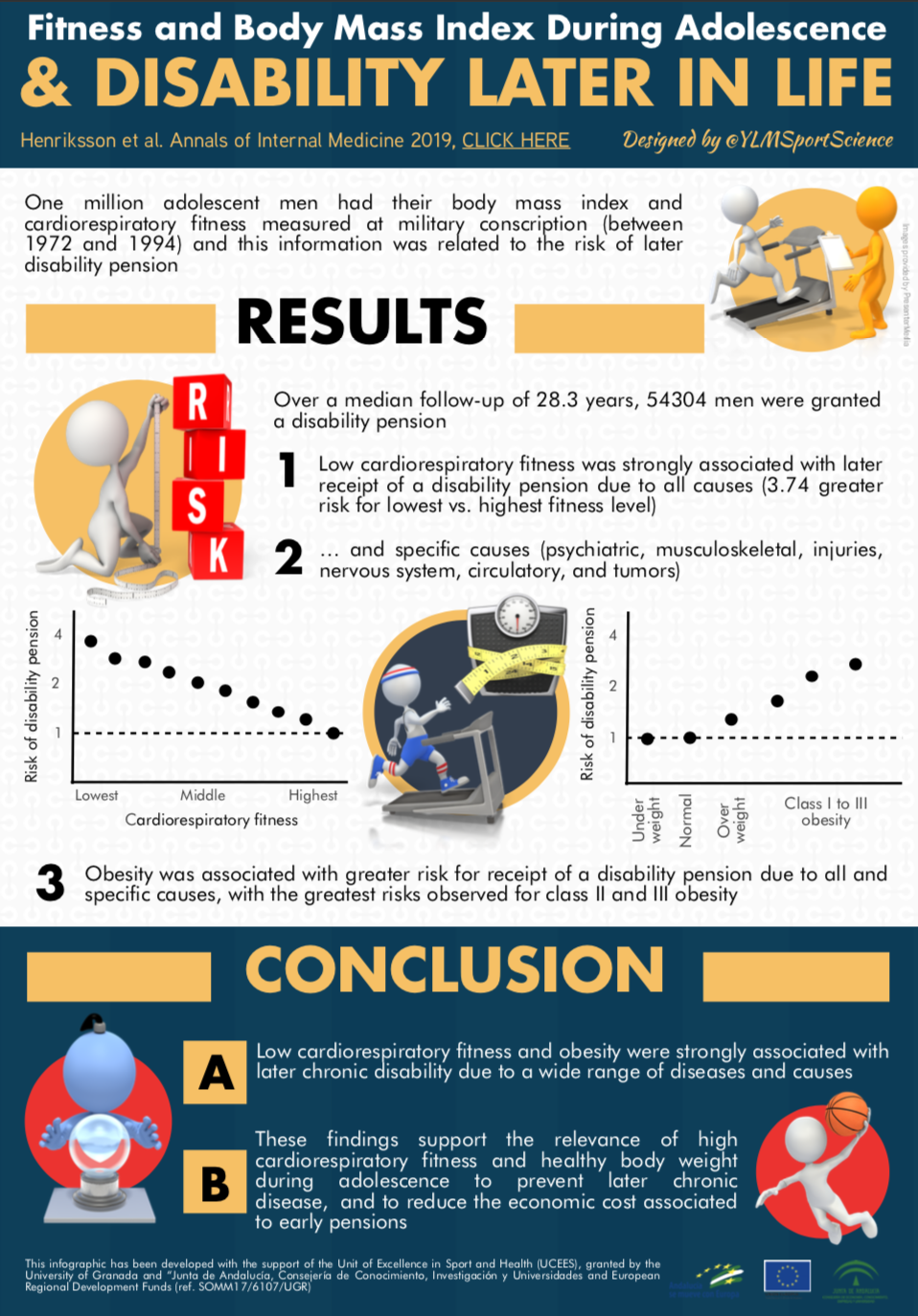By Pontus Henriksson, Hanna Henriksson, Per Tynelius, Daniel Berglind, Marie Löf, I-Min Lee, Eric J Shiroma and Francisco B Ortega
Low levels of cardiorespiratory fitness and/or obesity in adolescence has been linked to greater risks of mortality and morbidity later in life (1-3), but considerably less is known regarding the association of cardiorespiratory fitness and obesity with the risk of later chronic disability. Thus, we examined and published results of the associations of cardiorespiratory fitness and body mass index with later disability pension in a large population-based sample of over 1 million Swedish male adolescents (4). In this infographic, we summarize and present the main findings of our previous paper in an English and Spanish version that were created together with Yann Le Meur from YLMSportScience.
Briefly, we examined the associations of cardiorespiratory fitness and body mass index (BMI) with later disability by Cox proportional hazards regression models. Presented models were adjusted for conscription year, conscription center, age at conscription and childhood socioeconomic position (as measured by parental education), any mental hospitalization before conscription and any psychiatric diagnosis at conscription as well as BMI and cardiorespiratory fitness at conscription (when not included as exposure in the model).
As shown in the infographic below, both low cardiorespiratory fitness (hazard ratio, 3.74; 95% CI, 3.55-3.95 for lowest vs. highest fitness decile) and obesity (hazard ratio, 3.21; 95% CI, 2.49-4.15 for obesity vs. normal weight) in adolescence were strongly associated with later disability pension. Thus, our findings display the relevance of high cardiorespiratory fitness and healthy body weight during adolescence in relation to later disability.
***
Pontus Henriksson, PhD; Hanna Henriksson, PhD; Per Tynelius, MSc; Daniel Berglind, PhD; Marie Löf, PhD; I-Min Lee, MBBS and ScD; Eric J Shiroma, ScD; Francisco B Ortega, PhD
Department of Physical Education and Sports, Faculty of Sport Sciences, University of Granada, Corresponding author: Pontus Henriksson, Department of Biosciences and Nutrition, Karolinska Institute, SE-14183 Huddinge, Sweden. E-mail: pontus.henriksson@ki.se. Telephone: +468 524 800 00.
Correspondence to: Pontus Henriksson, Department of Biosciences and Nutrition, Karolinska Institute, SE-14183 Huddinge, Sweden. E-mail: pontus.henriksson@ki.se. Telephone: +468 524 800 00.
Funding: This infographic has been developed with the support of the Unit of Excellence in Sport and Health (UCEES), granted by the University of Granada and “Junta de Andalucía, Consejería de Conocimiento, Investigación y Universidades and European Regional Development Funds (ref. SOMM17).
Competing interests:
None declared.
Author note: This infographic is based on a study by the authors (Henriksson P et al. Ann Intern Med 2019. doi: 10.7326/M18-1861).
References
- Hogstrom G, Nordstrom A, Nordstrom P. Aerobic fitness in late adolescence and the risk of early death: a prospective cohort study of 1.3 million Swedish men. Int J Epidemiol 2016;45:1159-68.
- Ortega FB, Ruiz JR, Castillo MJ, Sjostrom M. Physical fitness in childhood and adolescence: a powerful marker of health. Int J Obes 2008;32:1-11.
- Ruiz JR, Castro-Pinero J, Artero EG, et al. Predictive validity of health-related fitness in youth: a systematic review. Br J Sports Med 2009;43:909-23.
- Henriksson P, Henriksson H, Tynelius P, et al. Fitness and Body Mass Index During Adolescence and Disability Later in Life: A Cohort Study. Ann Intern Med. Feb 12 2019. doi: 10.7326/M18-1861. [Epub ahead of print].
